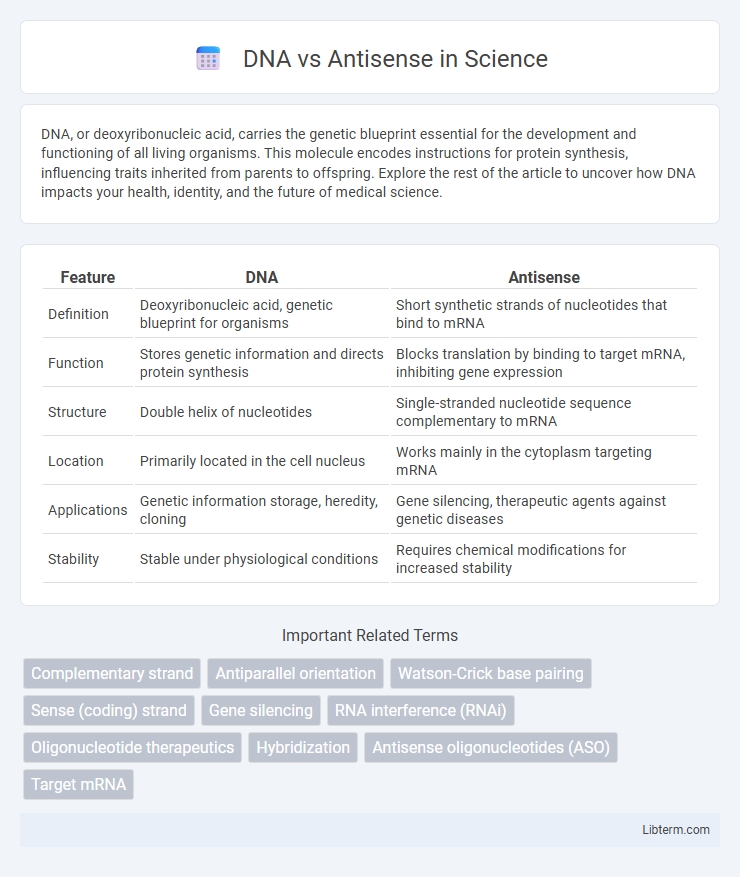DNA, or deoxyribonucleic acid, carries the genetic blueprint essential for the development and functioning of all living organisms. This molecule encodes instructions for protein synthesis, influencing traits inherited from parents to offspring. Explore the rest of the article to uncover how DNA impacts your health, identity, and the future of medical science.
Table of Comparison
| Feature | DNA | Antisense |
|---|---|---|
| Definition | Deoxyribonucleic acid, genetic blueprint for organisms | Short synthetic strands of nucleotides that bind to mRNA |
| Function | Stores genetic information and directs protein synthesis | Blocks translation by binding to target mRNA, inhibiting gene expression |
| Structure | Double helix of nucleotides | Single-stranded nucleotide sequence complementary to mRNA |
| Location | Primarily located in the cell nucleus | Works mainly in the cytoplasm targeting mRNA |
| Applications | Genetic information storage, heredity, cloning | Gene silencing, therapeutic agents against genetic diseases |
| Stability | Stable under physiological conditions | Requires chemical modifications for increased stability |
Introduction to DNA and Antisense
DNA, or deoxyribonucleic acid, is the hereditary material in almost all living organisms, encoding genetic instructions for development, functioning, and reproduction. Antisense molecules are short, synthetic strands of nucleic acids designed to bind specifically to complementary mRNA sequences, thereby inhibiting gene expression. The fundamental difference lies in DNA serving as the genetic blueprint, while antisense technology manipulates gene expression by targeting messenger RNA.
Understanding DNA: Structure and Function
DNA consists of a double helix formed by nucleotide pairs containing deoxyribose sugar, phosphate groups, and four bases: adenine, thymine, cytosine, and guanine, which code genetic information. This structure enables DNA to store and transmit hereditary data through replication and transcription processes essential for protein synthesis. Antisense molecules, by contrast, are short strands of nucleotides designed to bind complementary sequences in RNA, blocking gene expression selectively.
What is Antisense? Definition and Mechanism
Antisense refers to a strand of nucleic acid complementary to a specific messenger RNA (mRNA) sequence, designed to bind and inhibit its function. This mechanism involves antisense oligonucleotides (ASOs) hybridizing with target mRNA, preventing translation and thereby reducing protein production. Antisense technology is utilized in gene silencing therapies to modulate gene expression at the RNA level.
Key Differences Between DNA and Antisense
DNA is a double-stranded molecule carrying genetic information essential for biological functions, while antisense refers to single-stranded nucleic acid sequences designed to bind specifically to messenger RNA (mRNA) to inhibit gene expression. The primary difference lies in their roles; DNA acts as the blueprint for protein synthesis, whereas antisense molecules serve as targeted regulators or suppressors of gene activity. Antisense technology is widely used in research and therapeutic applications to modulate gene expression, contrasting with DNA's fundamental role in heredity and cellular function.
Biological Roles of DNA vs. Antisense Sequences
DNA stores genetic information in the form of nucleotide sequences that encode proteins and regulate cellular functions, serving as the blueprint for organism development and maintenance. Antisense sequences are complementary strands of nucleotides that bind to specific mRNA transcripts, modulating gene expression by blocking translation or promoting degradation. The biological role of DNA is primarily long-term genetic information storage, whereas antisense sequences function in post-transcriptional regulation and gene expression control.
Antisense Technology in Genetic Research
Antisense technology involves using synthetic strands of nucleic acids designed to bind specifically to target mRNA sequences, effectively blocking gene expression and allowing precise regulation of genetic activity. Compared to DNA-based methods, antisense oligonucleotides offer a reversible and highly specific approach to gene silencing, making them invaluable in studying gene function and developing targeted therapies. Recent advances include enhanced delivery systems and chemical modifications, which improve stability and cellular uptake, significantly advancing genetic research and personalized medicine applications.
Therapeutic Applications: DNA vs. Antisense Oligonucleotides
DNA therapeutics involve the delivery of plasmid DNA or gene-editing constructs to restore or modulate gene function, primarily targeting inherited genetic disorders and cancer. Antisense oligonucleotides (ASOs) are short, synthetic single-stranded nucleotides designed to specifically bind messenger RNA (mRNA), altering splicing, inhibiting translation, or promoting degradation to treat diseases such as spinal muscular atrophy and Duchenne muscular dystrophy. The precision of ASOs in selectively modulating gene expression without altering the genome distinguishes them from DNA therapies, which often aim for permanent genomic integration or correction.
Advantages and Limitations of Antisense Approaches
Antisense approaches offer high specificity by targeting mRNA sequences to inhibit gene expression, enabling selective modulation of disease-related genes with minimal off-target effects. These methods allow reversible gene silencing, providing temporal control over therapeutic interventions compared to permanent genetic alterations in DNA-based editing. However, antisense oligonucleotides face limitations such as poor cellular uptake, susceptibility to nuclease degradation, and potential immune activation, necessitating advanced chemical modifications and delivery systems to enhance stability and efficacy.
Future Directions in DNA and Antisense Studies
Future directions in DNA and antisense studies emphasize the integration of CRISPR-based gene editing with antisense oligonucleotide (ASO) therapies to enhance specificity and reduce off-target effects. Advances in nanoparticle delivery systems aim to improve cellular uptake and stability of DNA and antisense molecules, expanding their therapeutic potential for genetic disorders and cancer. Emerging research on epigenetic modulation through antisense sequences is poised to revolutionize gene regulation techniques, offering precise control over gene expression in clinical applications.
Summary: Comparing DNA and Antisense in Modern Science
DNA serves as the fundamental genetic blueprint in living organisms, encoding the instructions for protein synthesis and cellular function. Antisense technology utilizes synthetic strands of nucleotides designed to bind specifically to target mRNA sequences, effectively inhibiting gene expression post-transcriptionally. This approach contrasts with DNA's role by enabling selective gene regulation, making antisense a powerful tool in genetic research, therapeutic development, and precision medicine.
DNA Infographic

 libterm.com
libterm.com